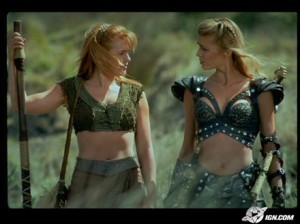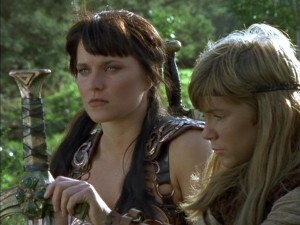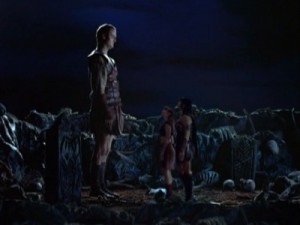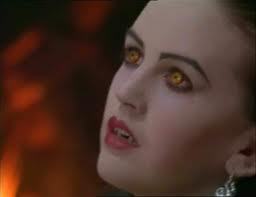Tansy Rayner Roberts's Blog, page 155
October 18, 2010
How Do You Mortals Get From Day To Day? [Xena Rewatch 2.5-2.8]
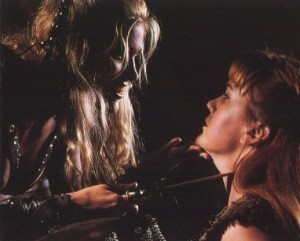 2.5 Return of Callisto
2.5 Return of Callisto
This episode is a real game-changer.
Gabrielle marries her childhood sweetheart Perdicas (yes we're still forgetting what she said about him in episode one) and leaves her life with Xena to be a wife; meanwhile, Callisto escapes from her life imprisonment even nuttier than before, and goes on a fairly singular killing spree, leaving Gabrielle widowed after less than a day. Xena and Gabrielle fight over whether Gab can take revenge herself and ultimately Xena is the one who does it, allowing Callisto to die rather horribly in a swamp of sadness – sorry, quicksand!
There's a lot of interesting material in this episode. Gabrielle is unsure about whether she is going to accept Perdicas' offer of marriage, but his story of how he has tired of being a soldier-for-hire moves her, and later when she sees him freeze in horror after killing a man in a battle, she decides her answer is 'yes.' The irony is that Xena had to rescue Gabrielle in that battle BECAUSE Perdicas froze up – if we read this episode (which we are invited to) as being about Gabrielle choosing between two life partners, it leaps out at us that Xena's competence in battle is what rules her ineligible for Gabrielle's heart, even as she saves her life. Meanwhile, Perdicas on his knees staring into space is what makes Gabrielle go all soppy.
I always notice the wedding scene in this episode because I remember reading about the costume design – one choice that they made in the design of Xena was to avoid all use of white in order to make the show look extra "dark" especially in comparison to Hercules. This is especially noticeable in this season, which has so many night shoots. Gabrielle and Perdicas wear a cream colour rather than proper white – the whitest thing on screen is the crown of daisies – but it's still an unusual splash of brightness. (they must have loosened up about this rule by the time the Hestian Virgins go on the rampage in the season finale) I love that Gabrielle looks like a real person, a rare thing in a TV bride – the dress is new, but she wears her old boots under it because come on, it's not like she has a second pair of shoes.
Callisto is at her wide-eyed psycho best in this season, and this episode has some brilliant fight scenes between her and Xena. There is something about these two with their screaming and hacking at each other that leads you to think Xena is usually holding back, but with Callisto she can be free to be an utter maniac. It's especially noticeable because when Xena fights men it is often 5-6 at a time – but you completely believe that this slender little waif of a thing in a metal bikini is an equal match for Xena.
The theme of the episode is killing – who can kill, and why, and why you shouldn't. While the term 'blood innocence' which took on such significance in Season 3 is never actually mentioned, it is clearly at the forefront of Xena's mind as Gabrielle demands vengeance for her fallen husband. There is a quite awful scene in which Gabrielle forces Xena to teach her how to use a sword, and you can see how much Xena is hating it, even as she accepts that it is better than Gabrielle going in helpless – though of course, as Xena knows all along, Gabrielle is not capable of killing anyone, even Callisto.
 The final scene is another emotionally wrecking one, despite the fact that Callisto is a stone cold bitch – the idea that doing violence has an effect on your own soul goes very deep here, and we go from a great screamy chariot scene to the two women, Xena and Callisto, trapped in the quicksand. Xena saves herself and Callisto sinks. That choice will have ramifications for the whole season to come. Yay ramifications!
The final scene is another emotionally wrecking one, despite the fact that Callisto is a stone cold bitch – the idea that doing violence has an effect on your own soul goes very deep here, and we go from a great screamy chariot scene to the two women, Xena and Callisto, trapped in the quicksand. Xena saves herself and Callisto sinks. That choice will have ramifications for the whole season to come. Yay ramifications!
This was one of the episodes that started me watching and loving the show, instead of just being amused/vaguely interested. There's a whole stretch of very cool episodes coming up, and some very creative uses of Hudson Leick, one of the show's many great casting choices. Stay tuned.
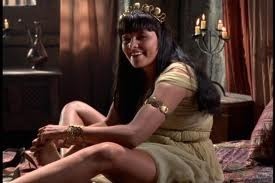 2.6 Warrior… Princess… Tramp
2.6 Warrior… Princess… Tramp
Meg the wench makes an appearance as the second Xena look-alike, who turned out to have a lot more narrative use than the sweet but story's-over-now Princess Diana.
The usual comedy of errors works to great effect here, and is made especially fun by Meg's genuine, lusty interest in Joxer. As Xena puts it "if you meet someone who looks like me and she shows any interest whatsoever in you as a man, it's the Bad One."
And indeed Meg is bad, in that she is part of a plan to replace Princess Diana and steal the throne. I was uncomfortable though with the way she is identified as a 'tramp' and how her sluttiness is constantly held up as an evil character trait. The language used is problematic – it is implied that she might be a prostitute, but so coyly that it comes across as everyone thinking she's worthless because she puts it about a bit, not because she sells her body for money. Not that it's a GOOD thing to go around being all judgemental about working girls, but in this case because her profession isn't specified, she gets all the judgement but none of the respect. Or something.
Also we return to the baby hurling antics of season one, with a baby hoisted in a basket over a fire and flung into the air no less than four times! So glad I kept that line in the Chakram Statistics.
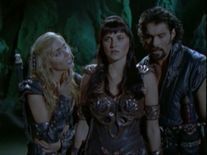 2.7 Intimate Stranger
2.7 Intimate Stranger
In the first of many, many, MANY returns from the dead, Callisto visits Xena in her dreams and gets her to admit her guilt for deliberately letting her enemy die – then uses that confession to swap places with her.
Once in Xena's body, Callisto fools Gabrielle, wounds a suspicious Argo, and starts building an army for herself, when not snogging/shagging Ares' brains out. Meanwhile, in Callisto's body, Xena convinces Hades of her real identity and pursues her nemesis – with only 24 hours to send her back to Tartarus in her place.
Body swap is a classic spec fic storyline, and like other classics – the parallel world, the musical, the groundhog day – it works best with an excellent and established ensemble cast. Lucy Lawless has already shown her chops in the doppleganger episodes, and now pulls off a brilliant impersonation of Hudson Leick's Callisto. Hudson likewise gives Lucy a run for her money with a quiet, understated Xena impersonation.
And oh yes, while Ares has always been obsessed with Xena, this is the first time we see how hot for her he really is – sure, the first time we see he and Callisto all over each other, she's in her own body, but they most definitely consummate their relationship at least once while she's "wearing" Xena. (Ick factor to the NTH degree) The clever part is that the script never actually reveals that the two are quite blatantly using each other, but everything we know about those characters and see in the performances makes it very clear that for both Ares and Callisto, sex is just another business transaction.
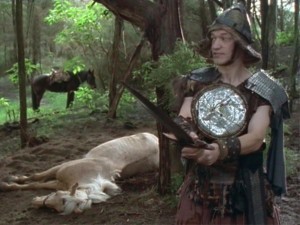 Joxer also gets a hero moment in this one, standing up to whom he thinks is Callisto to defend Xena's horse Argo – while Xena has always rolled her eyes at Joxer's presence before, you can see that this changes her opinion of him and her attitude is a lot more of loving exasperation rather than genuine annoyance in future.
Joxer also gets a hero moment in this one, standing up to whom he thinks is Callisto to defend Xena's horse Argo – while Xena has always rolled her eyes at Joxer's presence before, you can see that this changes her opinion of him and her attitude is a lot more of loving exasperation rather than genuine annoyance in future.
The story is powerful and the acting even better, but the killer twist is at the end of the episode, when Xena is left on earth in Callisto's body. An accident during a publicity stunt for Letterman had Lucy Lawless dealing with a back injury, and one of the ways the production crew chose to deal with it was to have Hudson continue to play Xena for another episode…
 2.8 Ten Little Warlords
2.8 Ten Little Warlords
Without Lucy Lawless around to steal the show, Hudson Leick continues her excellent Xena performance. It's to her credit that, as with Lucy in the Diana/Meg episodes, you never forget whom Hudson is playing – every expression, glance and even her vocal tones are Xena all the way. Damn this actress is good – why didn't she go places?
It helps that this is a good story, revolving around the theft of Ares' powers. Ares without his godhood is always hilarious, which is probably why they did it so often – though really, by the time season six rolled around, he should have been used to it. This is the first time, though, and it's lovely.
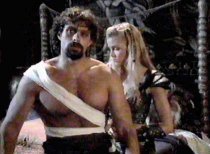 Hudson-Xena and the bedraggled powerless Ares make a great team, and I would happily have watched them for six episodes – though to be fair they couldn't have lasted more than three without ripping each other's clothes off, and it would have turned into a whole different kind of show…
Hudson-Xena and the bedraggled powerless Ares make a great team, and I would happily have watched them for six episodes – though to be fair they couldn't have lasted more than three without ripping each other's clothes off, and it would have turned into a whole different kind of show…
With better material to work with, Kevin Smith is sizzling up the screen in this season! So much better than his shoddy scripts from season one. His performance is in turn soulful, snarky, slapsticky and… colossal arse. He can shift from one to another on the turn of a dime. Also, he looks excellent in leather pants.
Also, while Xena was infuriated with Princess Diana's mad hairbrushing obsession back in the day, she quite obviously brushes her hair a lot more than Callisto does. This is all I am saying.
CHAKRAM STATISTICS:
Boys who want romance with Xena: 7
Boys Xena allows to romance her: 2
Xena dead boyfriends: 2
Gabrielle dead boyfriends: 2/7
"Adorable" children: 23
Babies: 4
Babies tossed humorously in the air during fight scenes: 6
Xena doppelgangers: 3
Xena sings at a funeral: 2
Xena dies: 1
Gabrielle dies: 1
Characters brought back from the dead (including ghosts and visits to the Underworld): 10
Ares loses his powers and goes all to pieces about it: 1
Xena or Gabrielle earns money: 1
Xena or Gabrielle spends money: 3
Out of the Pantheon: Morpheus, Ares, Hera, the Titans, Hades, Celesta, Charon, the Fates, Bacchus
The Celebrity Red Carpet of the Ancient World: Pandora, Prometheus, Hercules, Iolaus, Sisyphus, Helen of Troy, Paris, Deiphobus, Menelaus, Euripides, Homer, Autolycus, Meleager, Oracle of Delphi, David, Goliath, Orpheus
Previous Xena Rewatch Posts:
Warlord is a Lady Tonight
I Don't Work For Money
Amazon Wanna Take A Ride?
Go To Tartarus!
Swashbuckle and Shams
Death In A Chainmail Bikini
Full Moon It Must Be Xena
October 17, 2010
Raeli's Playlist – the Trock Years
Right now, her favourite song to listen to in the car is… "Journey's End" by Chameleon Circuit. Sad but true!
(vid has, well, pretty much all the spoilers for Doctor Who – Journey's End. Remember when that skinny chap in the suit was the Doctor?)
October 16, 2010
Happy Birthday Blog!
I have been meaning to check all week on what date I actually started this blog because I had some idea that it was a year or so – and hooray, it was in fact a year today! I'm terribly comfy over here at Wordpress, though I am also happy to have a foot in LJ and to continue having great conversations in the comments.
This is my 440th post since I moved to the new blog, which is… okay, that's a LOT, isn't it? You'd think considering how much time I spend on Twitter, I'd be posting less than once a day.
By this time next year I should have two more novels on the shelves, and have finished the first Nancy Napoleon novel, FURY (I just like writing it in capitals). My girls will be 6 3/4 and 2, respectively. And, quite possibly, I'll have written another 440 posts…
Here are my Top 20 posts from Year One of Stitching Words:
October – Ten Roman Festivals That Are Weirder Than Halloween
November – Myths of Nanowrimo
Women are Small, Men are Universal
Writing Doesn't Have to Be Your Job… unless it does
December – Why I Read Women
Lone Princesses and Girly Books
January – Writing While the House is Messy
February – Other People's Sons and the Gendered Shopping Experience
March – My Top Ten Super-Solo-Unsequelled-Standalone Fantasy Novels
Ruining Young Men's Lives
April – Because Trilogies Are Awesome
On Reading Bad Books
May – My First Favourite Female Fantasy Heroes
A Question of Canon-Building
June - You Should Read This Right Now, I'll Wait
July – Blyton Lite Easy Meals ™
On Court Fantasy
10 Greatest TV Characters of All Time
August – How to Read Big Fat Fantasy
September – Relentless Adaptations and Seamonsters and Vampires and a Latte Please
Life, it happens
You know I should be working, but. Sometimes you just have to allow the well to be replenished – not just creative energy, but personal energy. Enough spark to be able to look after a baby and a school girl every day of the week!
Last night, we went to see a great local production of Spamalot, which was not only great fun, but interesting from the point of view of a writer. I love analysing the adaptation process, and in this case was intrigued to see what they had done to turn Monty Python and the Holy Grail into a stage musical – adding more production numbers and several iconic elements from other corners of the Monty Python oeuvre, sure, but the most noticeable change was the extra attempt to form a coherent narrative throughline. I particularly liked the way that several characters were combined in order to give several of the knights an effective backstory.
Also, seeing the Black Knight routine done on live stage? Classic.
Today, a gang of us went to the Frock Up event in Hobart – a vintage clothes indoor market, and an exhibition of royal clothing from the Victorian era. It was very cool getting to see so many adorable items of clothing and playing with fabrics, even though there was almost nothing there I could possibly fit into – though considering that the frocks ranged in price from about $120 to $900, this was not a bad thing! I did get a bargain on some scarves and a large amount of polka dot fabric, though. Plus, it was fun girlie time.
There were real flapper dresses there, gorgeous things, and frocks from the 30's, 40's, 50's… 60's mod mini dresses, and even some 80's monstrosities! I even saw a natty suit designed for Diana Rigg.
Afterwards we retired for coffee, cake & chat, and I returned to my family feeling all replenished and human. I even got ideas for a new short story and managed to write some of it this afternoon!
Tomorrow I hope to get back to the fixy-upping of Book 3, as there are a few scenes crying out for attention before I let anyone else look at the manuscript. Also I'm taking Raeli to a book launch of Kate Gordon's debut novel Three Things About Daisy Blue, which is also the 20th and final book of the Allen and Unwin Girlfriend series. I'm sad to see this awesome series of books end, but very excited for Kate.
October 14, 2010
Cryoburn, by Lois McMaster Bujold
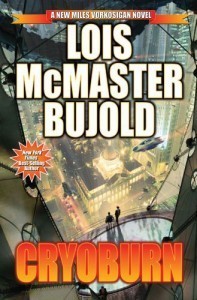 It occurred to me this week, particularly in context of the discussion about female-authored SF not getting enough attention (check out Jo Walton's post at Tor.com for the latest coverage and some fantastic author/book recs in the comments) that thanks to the wonder of early review copies, I have read two of the year's most important SF releases by women, and not reviewed them yet, because I'm a slacker and I read both long before their actual release dates.
It occurred to me this week, particularly in context of the discussion about female-authored SF not getting enough attention (check out Jo Walton's post at Tor.com for the latest coverage and some fantastic author/book recs in the comments) that thanks to the wonder of early review copies, I have read two of the year's most important SF releases by women, and not reviewed them yet, because I'm a slacker and I read both long before their actual release dates.
It then occurred to me that the release dates in question are so close now that I can legitimately review the books, and I really hope that I haven't waited too long to do so with authenticity!
Cryoburn, by Lois McMaster Bujold, is a book I (and many others) have been awaiting since approximately the end of time. I discovered the outstanding Vorkosigan saga some years ago (gosh at least ten now, I think) with the marvellous comedy of manners "A Civil Campaign". I then proceeded to catch up on all the previous books in entirely the wrong order, and with great glee. My first ebook reading (anyone else remember Mobipocket?) came about because of the difficulty of tracking down some of Bujold's more obscure works, which I believe have since been reprinted, possibly multiple times.
In other words, I'm a fan.
Diplomatic Immunity was the first new release that I got my hands on after I discovered Miles Vorkosigan and his chaotic ensemble of family and friends, and while it pressed a lot of the "oh look who's back" buttons, it felt ultimately like a bit of a damp squib – like the similarly bleh Cetaganda, it slipped quickly into the 'Bujold books I'm least likely to reread' pile, even as I reread Mirror Dance, Memory, Komarr, Civil Campaign, and even the very early volumes with voracious delight.
For most of this decade, Bujold has been writing fantasy, rather excellent examples of the genre, though nothing (it has to be said) that creates the same mad adoration that I feel for Miles Vorkosigan. I very much enjoyed her first two fantasy novels in particular, which did very clever things with magic and worldbuilding and protagonists, but, you know. NOT VORKOSIGAN.
I think a big part of the appeal of this madcap series of science fiction is that, much like my other great SF love Doctor Who, it incorporates so many different kinds of styles and stories that there is little chance of it going stale. From SF romance to political crunchiness to military space opera to thriller to family saga to murder mystery to comedy of manners, the novels show different sides of Miles Naismith Vorkosigan, a man who barely survived childhood and battles all manner of disabilities and yet is fierce and indestructible. As with any successful series, we gather repeat characters along the way, to whom it is easy to get rather attached. Miles' mother Cordelia, herself the hero of two early novels, an independent, liberal-thinking scientific woman who has chosen to spend her life as an aristocratic wife in a feudal society, but never stops stabbing holes in said society to make it a better place. His father Aral, a fossil and war hero who represents everything Miles values about honour and masculinity, and whose accomplishments Miles can only eclipse by achieving epic insanities at an intergalactic level. Ivan, the adorable and bumbling dope of a cousin. Elli Quinn, who chooses ships and battles over love and marriage because, DUH. Taura, a monstrous super-soldier who breaks everyone's hearts simply by existing. Mark, a damaged abuse victim who should have been a one-time character but kept coming back and growing and developing as a person. Ahem. I could go on, but will not.
Possibly it's time to talk about this actual book. Cryoburn, while not actually hitting the heights of my very very very favourite Vorkosigans (honestly it's hard to top Memory which is one of the best books I've ever read) has all the ingredients of a very successful Miles Vorkosigan outing. It also shows that yet again, Bujold is not afraid to take risks, to change up any patterns her series has developed, and even the world itself. I'm not going to address in the least the most important change she brings down upon Miles' world, because it's the massivest spoiler of all spoilers, but suffice to say – this is, like Civil Campaign and to some extent Diplomatic Immunity, a book which could stand very successfully as the last of the series, and yet unlike both those volumes it could as easily be the new beginning that refreshes the books so entirely that we see another five out in the next decade. Ms Bujold, in case you're wondering, I'm voting for the latter!
Cryoburn introduces us to two new point of view characters, another of those narrative choices that helps refresh and reinvent this series at regular points, rather than letting it stagnate into a single method. Roic, the guardsman who featured in the rather lovely romantic novella "Winterfair Gifts" earlier this decade, takes on one third of the novel, and Jin, a young boy at the heart of the mystery.
Because yes, this one is a mystery – or, to be more precise, a police procedural. This is very much the direction that these books have been moving for a while (with an exception made for A Civil Campaign) and this is an excellent example of the genre. The story takes place on Kibou-daini/New Hope, a planet obsessed with cryogenics, and the scientific extension of life. This theme, of immortality and the cost of extending life is explored in great depth throughout the novel, and it is that use of theme which lifts this beyond being an ordinary SF/crime hybrid into a powerful and unforgettable chapter in the Vorkosigan saga. While it works in many ways as a standalone novel, I don't think that the emotional impact would be nearly as effective for a new reader, so I recommend that someone looking to hop aboard the Vorkosigan train goes back to Shards of Honour, The Warrior's Apprentice, Brothers in Arms, Mirror Dance, or even (as I did) A Civil Campaign. To really understand the ending of this book, you're going to want a little grounding in Miles' background, and how he got to this particular place.
I should add, I loved the POV voice of Jin, the boy who sees Miles and his people through new eyes. Writing from the perspective of a child is tough to get right, but it works brilliantly as a way to remind us all who and what Miles is, to add that level of surprise at his capabilities (which his own people are pretty immune to by now) and to introduce us to this new planet and its social concerns. I was less interested in the POV voice of Roic, who didn't really have a plotline of his own to justify the use of his perspective, which seemed more to be an admin necessity, to report on events that Miles or Jin did not witness.
This is a good one. Not one of the best, but more than worth the wait. I really really hope that we get more, because I was left desperate to know what happens NEXT, and the glimpses of Barrayar were not nearly enough. Also, can you believe that after all these years, and with quite a lot of skipping ahead, Miles is still only 39? There's a lot of juice in this orange yet, and I am excited to see where Bujold takes us next. Just because this would make a powerful final book in the series doesn't mean it SHOULD.
October 13, 2010
Galactic Suburbia Episode 18 Special Horror Edition
New episode is up on iTunes! Download, streaming etc. will be available from www.galacticsuburbia.com sometime tomorrow…
in which we discuss translated awards, constructive feminist discourse on the internet, make a special Swancon announcement, and dissect our complex relationship with the horror genre.
News
Geffen Awards (Israel)
Torque Control discussion on women & the Clarke & the dire state of women in British SF, with list of all British releases of SF or SFnal books by women in 2010.
inspired by interview with Tricia Sullivan
Torque Control announces they will be blogging about 2010 British SF releases by women in December and ask for readers to join them. Also call for contributions of top 10 female authored SF books in the last decade for a theoretical "future classics' list.
Super Special Swancon Announcement!
What have we been reading/listening to?
TANSY: The Wiscon Chronicles IV edited by Sylvia Kelso
Azu Manga Daioh by Kiyohiko Azuma; Asimovs & F&SF, Salon Futura
ALISA: secret projects & another Book I Am Not Reading
Pet Subject: while Alex is away, let's talk about HORROR
- we're both pretty selective about the horror/dark fiction we read. What does it have to do to catch our eye?
- favourite horror/dark writers
- where do we draw the line on what we like/can appreciate in horror?
- does our feminism get in the way of reading/enjoying horror fiction?
Please send feedback to us at galacticsuburbia@gmail.com, follow us on Twitter at @galacticsuburbs and on Facebook! and don't forget to leave a review on iTunes!
The WisCon Chronicles, Vol 4, edited by Sylvia Kelso
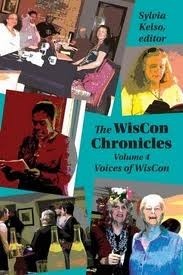 I was delighted to discover the existence of The Wiscon Chronicles a year or so ago, volumes which are intended to capture something of the vibe, spirit and content of the last several WisCons through selected articles, panel reports, interviews, blog entries and ephemera. I adored picking over the first three volumes and was beyond excited to see that my review of them had rated a blurb quote on the back of Volume 4.
I was delighted to discover the existence of The Wiscon Chronicles a year or so ago, volumes which are intended to capture something of the vibe, spirit and content of the last several WisCons through selected articles, panel reports, interviews, blog entries and ephemera. I adored picking over the first three volumes and was beyond excited to see that my review of them had rated a blurb quote on the back of Volume 4.
Notably this quote:
Which I still think holds true.
Another excitement was to see that this year's editor of the TWC is Australia's own Sylvia Kelso, whom I met for the first time recently. Sylvia herself talks in her introduction about the daunting challenge of trying to capture a convention she herself doesn't get to every year (being Australian) and indeed an event that no two people experience similarly. The clever thing about these books is that instead of trying to represent the convention by being as generic as possible, they instead try to share the deeply specific and personal, from a wide variety of people.
My only complaint about this volume is that while WisCon 33 (2009) is clearly marked out as the convention this book is commemorating, there was little to ground the reader in the basic information about that convention at the beginning, or indeed as the book continued. At the very least I would have liked to have known going into it whom the Guests of Honor where for this particular convention, something that is never entirely clear. (it was apparently Ellen Klages and Geoff Ryman, neither of whom are featured in this volume) This omission I am left feeling like the book is purely for the in crowd – like I should KNOW who those guests were, despite the event being a year and a half ago, and me being one of those people who can only live vicariously through WisCons by, you know, buying books about it!
As usual, we have a grab bag of interesting and at times emotionally affecting content. I very much enjoyed the focus on Tiptree Award winner Nisi Shawl and her experience at the con, as well as the experience of her mother who came along to share the event and contributes a letter about what it was like for her. I also enjoyed Nisi's "Glossiphilia" article which recorded a workshop on defining terms relevant to Cultural Appropriation, and included a record of many follow up suggestions and emails that came in after the convention. The mixture of "event record" and after-the-fact discussion is one of the great strengths of these books.
"Up Off Our Couches: Mental Illness Activism and Speculative Fiction" by JoSelle Vanderhooft was an extraordinary essay about the portrayal of mental illness in pop culture, and the perceptions of mental illness in everyday community, and how these two things intersect. This is a topic very dear to my heart and the article was crunchy and thought-provoking.
With "Haiku Earring Party" Elise Matthesen describes how this now-traditional WisCon party (in which attendees write poems in exchange for handmade pairs of earrings) got started, and shares some of the special moments she has experienced over the years. I found this story really sweet and inspirational, and I think it shows very much how WisCon differs from other conventions.
"Romance of the Robot" by Andrea Hairston was a great analysis of Wall E (and some other examples of robotic romance) and I will now not be able to look at that movie without interpreting Wall E and Eve as lesbians!
I think my favourite parts of the WisCon Chronicles are the panel reports and the one on "Transgressive Women Warriors" was particularly interesting, presented by Valerie Guyant and Kate Fruend, and followed up by an essay by Nancy Jane Moore in later response to said panel. I also enjoyed the Panel Notes on the topic of Male Answer Syndrome and the discussion that ensued, and the write ups of the "Something is Wrong on the Internet" and "Getting it Wrong Gracefully" panels.
The highlight of the book for me was "We See What You Did There," a group chat among various POC about their various experiences at the convention, and discussing their relationship with WisCon as a continuing event. This, combined with several standalone "My WisCon" con reports by different participants, definitely gives the impression that the book has achieved wide coverage as far as who and what WisCon is all about. (cough, apart from the Guests of Honour for that year)
October 11, 2010
Future Classics
You all know how much I love it when people start talking about celebrating female authors, right?
In response to the recent discussions about women and the Clarke Award, women in British SF etc. Torque Control has announced a couple of interesting blogging plans. Firstly they have announced a plan to actively discuss some of the 2010 (British) SF releases by women in the first week of December, and are calling for other readers to pick some up (if they haven't already) and join the discussion.
Here's the list, which is not restricted to British authors, but to books by women released by British publishers in 2010 – as you can see there are a few Aussies on there!
Candor, Pam Bachorz
Zoo City, Lauren Beukes
Servant of the Underworld, Aliette de Bodard
Alice in Time, Penelope Bush
Transformation Space, Marianne de Pierres
Mockingjay, Suzanne Collins
Guardians of Paradise, Jaine Fenn
[The Nemesis List, RJ Frith?]
Feed, Mira Grant
The Carbon Diaries 2017, Saci Lloyd
The Birth of Love, Joanna Kavenna
The Returners, Gemma Malley
The Legacy, Gemma Malley
[The Folding Knife, KJ Parker?]
A Matter of Blood, Sarah Pinborough
The Dead-Tossed Waves, Carrie Ryan
Birdbrain, Johanna Sinisalo
2017, Olga Slavnikova
Lightborn, Tricia Sullivan
Our Tragic Universe, Scarlett Thomas
Walking the Tree, Kaaron Warren
Naturally I'm dying to be involved. My fingers were itching for Book Depository, but then I stopped myself because I had sort of decided not to buy any more books this year thanks to the "getting stupid now" nature of my to read shelf. Luckily I can still be involved thanks to said shelf – I have the Mira Grant, Suzanne Collins and Marianne De Pierres books right there, waiting to go!
The other part of the Torque Control call to arms is in response to the all male list of "Future Classics" published by Gollancz. Niall Harrison has asked for readers to email him with their own lists of top 10 SF (choose your own definition) books by women published in the last 10 years.
We remember how much I love lists, right?
It's not whittled down to 10 yet but here are some of the books I want on my list:
Bold as Love, Gwyneth Jones
The Time Traveller's Wife, Audrey Niffenegger
Farthing, Jo Walton
Nylon Angel, Marianne de Pierres
Passage, Connie Willis
Lavinia, Ursula Le Guin
Less Than Human, Maxine McArthur
Fallen Gods, Kate Orman (and Jonathan Blum, but I still want to count it)
The Empress of Mars, Kage Baker
Carnival, Elizabeth Bear
Spirit, Gwyneth Jones
New Amsterdam, Elizabeth Bear
The Hunger Games, Suzanne Collins
Blackout/All Clear, Connie Willis
Lifelode, Jo Walton
Full Moon It Must Be Xena [Xena Rewatch 2.1-2.4]
A few key points of art direction as we groove our way into Season 2:
While the production team in Season 1 seemed to go to great lengths to avoid any night shoots at all (do we remember the scene in which Gabrielle & Diana lie down to sleep in the middle of the day?) this new season features night scenes in nearly every episode, as well as many more sunrise and sunset shots. This also leads to the iconic 'full moon' shot which used to cause me much merriment. It's always full moon in Xena. Every single time.
Also, Gabrielle is now wearing her classic outfit which was to represent her character over the next two and a half years: teeny sage green top showing off midriff, low-slung plum suede skirt, fighting staff. I love this outfit of hers, which still sums up 'Gabrielle' to me and it took me a long time to come to terms with her later style changes, especially the cutting of her hair. It was an important change, though, marking her ascension from Xena's junior assistant to her partner.
This episode is notable for introducing us to Solan, Xena's long lost son. It's also the first time we hear the name of Borias, Xena's lover and the father of her son, the warlord who turned his back on evil before she did, who will come to be such an iconic part of her backstory. Solan has been raised by centaurs, and while he takes pride in being the son of Borias he has no idea who his mother is.
It's an interesting enough insight into Xena's past, but the episode itself don't have much to it apart from the scenes with Xena and Solan. There's a shiny evil stone, one of Xena's former lieutenants wants it, lalala. Disposable ep. (though to be fair the Ixion stone will be highly relevant in a major two parter within a year or so – but not a Xena one!)
In defending the temple of the Fates, Xena kills a masked warrior who turns out to be a child. She is so upset that the Fates make her an offer: she can live the life she would have had if she had never picked up a sword, as long as she never spills a drop of blood.
This is a clever timey wimey sort of episode that builds on Xena's backstory very effectively. Her baby brother Lyceus is still alive, which brings her great joy, but in this reality the warlord Cortez took her village, and her mother is dead. Step by step, she comes to terms with the person she is, and the person she could have been.
The really creepy part of this episode is the youngest Fate, who in a year or so will play young Callisto, and has a similarly deadened stare. It's a nice touch to have the same actor back playing Cortez, though. The relationship between Xena and a hardened slave version of Gabrielle is very touching, and I was pleased to see Xena did actually take the initiative to choose which life was the better one, rather than having Lyceus get killed to make the decision for her, which is where I thought the story was taking us.
This is probably one of the better let's-pretend-the-Bible-is-just-another-mythology stories. Xena rings in a bitter anniversary with an old friend, forgetting to mention beforehand to Gabrielle that he is a giant. He has signed up with a war party to support them in their fight against a minority group of (apparently nomadic) "Israelites".
Gabrielle hangs out with the Israelites and starts flirting heavily with the second son of their leader, a boy called David. Yep, Xena's pal is Goliath. Booyah!
I like the fact that Goliath is largely a sympathetic figure in this story, though obviously doing the wrong thing, and it's nice to see Xena dealing with the moral ambiguity of having to fight a friend whose only crime is being on the wrong side. I have to say, though, for someone who was killing and maiming not so long ago, Xena does a nice turn in I Am Judging You So Hard Right Now.
Gabrielle is utterly bemused that the boy she is flirting with turns out to have a fiancee. Doesn't he KNOW that all the unattached lads under 20 are reserved for Gab-flirting?
The most important aspect of the episode is of course the Israelites themselves, a tribe who will return again and again, growing in stature and relevance to the Xenaverse mythology, much like the Amazons but without all the headbanging dance moves and cute outfits.
This is probably one of the most artistically ambitious episodes so far. The Bacchae are presented as vampires, and it's interesting how easily the two different mythologies dovetail together. I wasn't keen on this episode much in the past, mainly because I dislike the classic cop-out ending of so many pre-Buffy vampire stories; the kind where, once you kill the head vamp, all the other vampires reclaim their humanity. Boring!
There is some great use of weird horror movie style cinematography in this episode, and I do enjoy the disembodied head of Orpheus. They were clever to bring back Joxer for this particular story, as Ted Raimi is one of the few comic actors who can carry off talking to a disembodied head with such aplomb, and it's a credit to him that those sequences work so well when they could have been BEYOND stupid. The double bluff of setting up Xena as a possible Bacchae was well played out, as was Gabrielle's seduction into the Bacchae lifestyle, and shocking visual effect of Gab-as-monster.
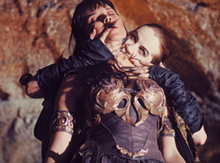 Speaking of pre-Buffy, at this point Xena is still 5 months away from the first ever screening of the Buffy pilot, and I looked that up because of a couple of key points in this episode. The portrayal of Bacchus with his big horns is powerfully reminiscent of that dude in Legend, and you might remember that Buffy also did this with the Judge in their own Season 2.
Speaking of pre-Buffy, at this point Xena is still 5 months away from the first ever screening of the Buffy pilot, and I looked that up because of a couple of key points in this episode. The portrayal of Bacchus with his big horns is powerfully reminiscent of that dude in Legend, and you might remember that Buffy also did this with the Judge in their own Season 2.
Also, a scene in this episode pre-empts Joss Whedon's classic reversal moment from the very first scene of the Buffy pilot, in which a predatory bloke is attacked by a not-so-vulnerable-after-all girl who proves to have very sharp teeth. Aww, Joss, and we all thought you were so original!
CHAKRAM STATISTICS:
Boys who want romance with Xena: 7
Boys Xena allows to romance her: 2
Xena dead boyfriends: 2
Gabrielle dead boyfriends: 1/7 (I am so counting David as a bf though he did not reciprocate her interest)
"Adorable" children: 23
Babies: 3
Babies tossed humorously in the air during fight scenes: 2
Xena doppelgangers: 1
Xena sings at a funeral: 1
Xena dies: 1
Gabrielle dies: 1
Characters brought back from the dead (including ghosts and visits to the Underworld): 9
Xena or Gabrielle earns money: 1
Xena or Gabrielle spends money: 2
Out of the Pantheon: Morpheus, Ares, Hera, the Titans, Hades, Celesta, Charon, the Fates, Bacchus
The Celebrity Red Carpet of the Ancient World: Pandora, Prometheus, Hercules, Iolaus, Sisyphus, Helen of Troy, Paris, Deiphobus, Menelaus, Euripides, Homer, Autolycus, Meleager, Oracle of Delphi, David, Goliath, Orpheus
October 10, 2010
It's the End but the Moment has been Prepared For (I have sticky notes to prove it)
Apologies for those who couldn't access this blog over the weekend – we had a domain name crisis, all sorted now.
Funnily enough, my thoughts have been very much on narrative endings, lately. How they work, how you drag all the threads together, how to make it satisfying, all that stuff. My head has been filled with the end of this book for six months now, and it still keeps pulling surprises on me. All I can hope at this point is that my characters don't gang up on me and murder me in my sleep. I would not put it past them!
I've always been fascinated by endings, and very critical of those that don't work, or that finish too early or too late. Diana Wynne Jones, whose books I love so much I could make a quilt of them to snuggle under on cold, sad days, always seems to me a little too hasty to finish, as if she stopped just half a chapter short of perfection. I allow this because it makes me less likely to stab forks into my arms in utter jealousy at how good she is. Then there's the Eddings duo and their lengthy, drawn out farewells which rival Tolkien for sheer self-indulgence (I'm pretty sure the end of the Elenium starts about a third of the way into the final book).
Then there are the perfect endings, the ones that make you feel calm and good (or awful, but in a good way) like "frankly my dear, I don't give a damn," and Janet writing Thomas a poem, and "Placet" (by both Sayers and Willis).
I love writing endings, normally. There's a beautiful bumbly tumbly pace to them, like running downhill very fast. That moment when everything slots into place and you know all the scenes you have to write, and it's just a matter of typing, and isn't it a good thing you have those mad typing skills that almost keep up with your brain at moments like this?
This one is proving harder than most, probably because I have more POV characters than I've ever handled before, and no I can't kill them all off just to make the throughline simpler, and then there's all the pressure I'm putting on myself to pay off all the promise of book 1 & book 2… I really hope writing endings isn't like flying in planes or taking exams, which is to say something which seemed easy peasy when I was seventeen and gets harder and harder the older I get.
It's certainly less fun than heading for 'THE END' used to be, but that could be because of the inevitability of certain events which are not all fluff and happiness, so instead of romping downhill crying tally ho! I am more sort of sidling up a cliffface with a guilty look on my face as I dispense justice and injustice with pinpoint accuracy amongst my characters.
The end must be in sight, cos new books are leaping into the queue in the hopes I will pay attention to them next. Yes, I said plural. Anything less would be far too easy…

